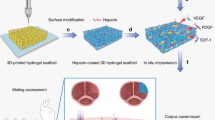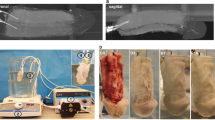Abstract
One of the causes of erectile dysfunction (ED) is the damaged penile cavernous smooth muscle cells (SMCs) and sinus endothelial cells (ECs). To investigate the feasibility of applying immortalized human mesenchymal stem cells (MSCs) to penile cavernous ECs or SMCs repair in the treatment of ED, the in vivo potential differentiation of the immortalized human MSCs toward penile cavernous endothelial or smooth muscle was investigated. One clone of immortalized human bone marrow mesenchymal stem cell line B10 cells via retroviral vector encoding v-myc were transplanted into the cavernosum of the Sprague–Dawley rats and harvested 2 weeks later. The expression of CD31, von Willebrand factor (vWF), smooth muscle cell actin (SMA), calponin and desmin was determined immunohistochemically in rat penile cavernosum. Multipotency of B10 to adipogenic, osteogenic or chondrogenic differentiation was found. Expression of EC specific markers (CD31 or vWF protein) and expression of SMC specific markers (calponin, SMA or desmin protein) were demonstrated in grafted B10 cells. When human MSCs were transplanted into the penile cavernosum, they have the potential to differentiate toward ECs or SMCs. Human MSCs may be a good candidate in the treatment of penile cavernosum injury.
This is a preview of subscription content, access via your institution
Access options
Subscribe to this journal
Receive 8 print issues and online access
$259.00 per year
only $32.38 per issue
Buy this article
- Purchase on Springer Link
- Instant access to full article PDF
Prices may be subject to local taxes which are calculated during checkout





Similar content being viewed by others
References
Miralles-Garcia JM, Garcia-Diez LC . Specific aspects of erectile dysfunction in endocrinology. Int J Impot Res 2004; 16: S10–S12.
Sainz I, Amaya J, Garcia M . Erectile dysfunction in heart disease patients. Int J Impot Res 2004; 16: S13–S17.
Liechty KW, MacKenzie TC, Shaaban AF, Radu A, Mosley AM, Deans R et al. Human mesenchymal stem cells engraft and demonstrate site-specific differentiation after in utero transplantation in sheep. Nat Med 2000; 6: 1282–1286.
Deng J, Petersen B, Steindler DA, Jorgensen ML, Latwell ED . Mesenchymal stem cells spontaneously express neural proteins in culture and are neurogenic after transplantation. Stem Cells 2006; 24: 1054–1064.
Silva GV, Litovsky S, Assad JA, Sousa AL, Martin BJ, Vela D et al. Messenchymal stem cells differentiate into an endothelial phenotype, enhance vascular density, and improve heart function in a canine chronic ischemia medel. Circulation 2005; 111: 150–156.
Pittenger MF, Mackay AM, Beck SC, Jaiswal RK, Douglas R, Mosca JD et al. Multilineage potential of adult human mesenchymal stem cells. Science 1999; 284: 143–147.
Kalka C, Masuda H, Takahashi T, Kalka-Moll WM, Silver M, Kearney M et al. Transplantation of ex vivo expanded endothelial progenitor cells for therapeutic neovascularization. Proc Natl Acad Sci USA 2000; 97: 3422–3427.
Orlic D, Kajstura J, Chimenti S, Jakoniuk I, Anderson SM, Li B et al. Bone marrow cells regenerate infarcted myocardium. Nature 2001; 410: 701–705.
Bang OY, Lee JS, Lee PH, Lee G . Autologous mesenchymal stem cell transplantation in stroke patients. Ann Neurol 2005; 57: 874–882.
Yang J, Zhou W, Zheng W, Ma Y, Lin L, Tang T et al. Effects of myocardial transplantation of marrow mesenchymal stem cells transfected with vascular endothelial growth factor for the improvement of heart function and angiogenesis after muocardial infarction. Cardiology 2006; 107: 17–29.
Verfailie CM . Adult stem cells: assessing the case for pluripotency. Trends Cell Biol 2002; 12: 502–508.
Rafii S, Lyden D . Therapeutic stem and progenitor cell transplantation for organ vascularization and regeneration. Nat Med 2003; 9: 702–712.
Kim SU, Stern J, Kim MW, Pleasure DE . Culture of purified rat astrocytes in serum-free medium supplemented with mitogen. Brain Res 1983; 274: 79–86.
Sun H, Wu C, Dai K, Chang J, Tang T . Proliferation and osteoblastic differentiation of human bone marrow-derived stromal cells on akermanite-bioactive ceramics. Biomaterials 2006; 27: 5651–5657.
Ciapetti G, Ambrosio L, Marletta G, Baldini N, Giunti A . Human bone marrow stromal cells: in vitro expansion and differentiation for bone engineering. Biomaterials 2006; 27: 6150–6160.
Carmeliet P, Moons L, Stassen JM, De Mol M, Bouche A, van den Oord JJ et al. Vascular wound healing and neointimal formation induced by perivascular electric injury in mice. Am J Pathol 1997; 150: 761–776.
Werner N, Priller J, Laufs U, Endres M, Bohm M, Dirnagl U et al. Bone-marrow derived progenitor cells modulate vascular reendothelization and neointimal formation: effect of 3-hydroxy-3-methylglutaryl coenzyme a reductase inhibition. Arterioscler Thromb Vasc Biol 2002; 22: 1567–1572.
Hibbert B, Olsen S, O'Brien E . Involvement of progenitor cells in vascular repair. Trends Vasc Med 2003; 13: 322–326.
Werner N, Junk S, Laufs U, Link A, Walenta K, Bohm M et al. Intravenous transfusion of endothelial progenitor cells reduces neointimaformation after vascular injury. Circ Res 2003; 93: 17–24.
Schmeisser A, Strasser RH . Phenotypic overlap between hematopoietic cells with suggested angioblastic potential and vascular endothelial cells. J Hematother Stem Cell Res 2002; 11: 69–70.
Pittenger MF, Martin BJ . Mesenchymal stem cells and their potential as cardiac therapeutics. Circ Res 2004; 95: 9–20.
Tse WT, Pendelton JD, Beyer WM, Egalka MC, Guinan EC . Suppression of allogeneic T-cell proliferation by human marrow stromal cells: implications in transplantation. Transplantation 2003; 75: 389–397.
Di Nicola M, Carlo-Stella C, Magni M, Milanesi M, Longoni PD, Matteucci P et al. Human bone marrow stromal cells suppress T-lymphocyte proliferation induced by cellular or nonspecific mitogenic stimuli. Blood 2002; 99: 3838–3843.
Le Blanc K, Tammik L, Sundberg B, Haymesworth SE, Ringden O . Mesenchymal stem cells inhibit and stimulate mixed lymphocyte cultures and mitogenic responses independently of the major histocompatibility complex. Scand J Immunol 2003; 57: 11–20.
Wu X, Huang L, Zhou Q, Song Y, Li A, Jin J et al. Mesenchymal stem cells participating in ex vivo endothelium repair and its effect on vascular smooth muscle cells growth. Int J Cardiol 2005; 105: 274–282.
Oswald J, Boxberger S, Jorgensen B, Feldmann S, Ehninger G, Bornhauser M et al. Mesenchymal stem cells can be differentiated into endothelial cells in vitro. Stem Cells 2004; 22: 377–384.
Spees JL, Olson SD, Ylostalo J, Lynch PJ, Smith J, Perry A et al. Differentiation, cell fusion, and nuclear fusion during ex vivo repair of epithelium by human adult stem cells from bone marrow stroma. Proc Natl Acad Sci USA 2003; 100: 2397–2402.
Terada N, Hamazaki T, Oka M, Hoki M, Mastalerz DM, Nakano Y et al. Bone marrow cells adopt the phenotype of other cells by spontaneous cell fusion. Nature 2002; 416: 542–545.
Ying QL, Nichols J, Evans EP, Smith AG . Changing potency by spontaneous fusion. Nature 2002; 416: 545–548.
Yamashita J, Itoh H, Hirashima M, Ogawa M, Nishkawa S, Yurugi T et al. Flk1-positive cells derived from embryonal stem cells serve as vascular progenitors. Nature 2000; 408: 92–96.
Devine SM, Bartholomew AM, Mahmud N, Nelson M, Patil S, Hardy W et al. Mesenchymal stem cells are capable of homing to the bone marrow of non-human primates following systemic infusion. Exp Hematol 2001; 29: 244–255.
Kotton DN, Ma BY, Cardoso WW, Sanderson EA, Summer RS, Williams MC et al. Bone marrow-derived cells as progenitors of lung alveolar epithelium. Development 2001; 128: 5181–5188.
Ferrari G, Cusella-De Angelis G, Coletta M, Paolucci E, Stomaiuolo A, Cossu G et al. Muscle regeneration by bone marrow-derived myogenic progenitors. Science 1998; 279: 1528–1530.
Saito T, Kuang JQ, Bittira B, Al-Khaldi A, Chiu RC . Xenotransplant cardiac chimera: immune tolerance of adult stem cells. Ann Thorc Surg 2002; 74: 19–24.
Hofstetter CP, Schwarz EJ, Hess D, Widenfalk J, El Manira A, Prockop DJ et al. Marrow stromal cells form guiding strands in the injured spinal cord and promote recovery. Proc Natl Acad Sci USA 2002; 99: 2199–2204.
Li Y, Chen J, Wang L, Zhang L, Lu M, Chopp M . Intracerebral transplantation of bone marrow stromal cells in a 1-methyl-4-phenyl-1,2,3,6-tetrahydropyridine mouse model of Parkinson's disease. Neurosci Lett 2001; 316: 67–70.
Alvarez-Donaldo M, Pardal R, Garcia-Verdugo JM, Fike JR, Lee HO, Pfeffer K et al. Fusion of bone-marrow-derived cells with Purkinje neurons, cardiomyocytes and hetatocytes. Nature 2003; 425: 968–973.
Mezey E, Key S, Volgelsang G, Szalayova I, Lange GD, Crain B . Transplanted bone marrow generates new neurons in human brains. Proc Natl Acad Sci USA 2003; 100: 1364–1369.
Deb A, Wang S, Skelding KA, Miller D, Simper D, Caplice ND . Bone marrow-derived cardiomyocytes are present in adult human heart: a study of gender-mismatched bone marrow transplantation patients. Circulation 2003; 107: 1247–1249.
Terada N, Hamazaki T, Oka M, Hoki M, Mastalerz DM, Nakano Y et al. Bone marrow cells adopt the phenotype of other cells by spontaneous cell fusion. Nature 2002; 416: 542–545.
Ying QL, Nichols J, Evans EP, Smith AG . Changing potency by spontaneous fusion. Nature 2002; 416: 545–548.
Pells S, Di Domenico AI, Callagher EJ, McWhir J . Multipotentiality of neuronal cells after spontaneous fusion with embryonic stem cells and nuclear reprogramming in vitro. Cloning Stem Cells 2002; 4: 331–338.
Author information
Authors and Affiliations
Corresponding authors
Rights and permissions
About this article
Cite this article
Song, Y., Lee, H., Park, I. et al. Potential differentiation of human mesenchymal stem cell transplanted in rat corpus cavernosum toward endothelial or smooth muscle cells. Int J Impot Res 19, 378–385 (2007). https://doi.org/10.1038/sj.ijir.3901539
Received:
Revised:
Accepted:
Published:
Issue Date:
DOI: https://doi.org/10.1038/sj.ijir.3901539
Keywords
This article is cited by
-
Improvement of damaged cavernosa followed by neuron-like differentiation at injured cavernous nerve after transplantation of stem cells seeded on the PLA nanofiber in rats with cavernous nerve injury
Molecular Biology Reports (2021)
-
Cancer stem cell secretome in the tumor microenvironment: a key point for an effective personalized cancer treatment
Journal of Hematology & Oncology (2020)
-
Towards clinical application of tissue engineering for erectile penile regeneration
Nature Reviews Urology (2019)
-
In Vivo MR Imaging of Dual MRI Reporter Genes and Deltex-1 Gene-modified Human Mesenchymal Stem Cells in the Treatment of Closed Penile Fracture
Molecular Imaging and Biology (2018)
-
Construction of engineered corpus cavernosum with primary mesenchymal stem cells in vitro
Scientific Reports (2017)



